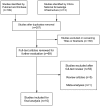Association of Mycoplasma pneumoniae infection with increased risk of asthma in children
- PMID: 28565772
- PMCID: PMC5443219
- DOI: 10.3892/etm.2017.4219
Association of Mycoplasma pneumoniae infection with increased risk of asthma in children
Abstract
The present study was conducted to investigate the relationship between Mycoplasma pneumoniae (MP) infection and the risk of asthma among children by detecting the rate of MP immunoglobulin M (MP-IgM) and the eosinophil (EOS) count. A total of 139 asthmatic children were enrolled as the case group and assigned into three groups: Group A (aged <3 years, n=42), group B (aged 3-8 years, n=45) and group C (aged >8 years, n=52). Additionally, 115 healthy children were enrolled in the control group. Enzyme-linked immunosorbent assay was used to measure the MP-IgM-positive rate. EOS count was detected in the experimental and control groups by using a hemocytometer analyzer. A meta-analysis was performed by using the Comprehensive Meta-Analysis version 2.0 software. The positive rates of the MP-IgM and EOS count in the experimental group were significantly higher than those in control group (both P<0.001). Furthermore, the asthmatic children in group C had a higher MP-IgM-positive rate and EOS count as compared to those in groups A and B, respectively (all P<0.05). Results from groups A and B were not statistically significant (all P>0.05). The meta-analysis further confirmed that asthmatic children had a higher MP-IgM-positive rate as compared to the healthy controls (P<0.001). Age-stratified analysis revealed that the MP-IgM-positive rate in asthmatic children aged ≥8 and <8 years was significantly higher than that in the healthy controls (P=0.003 and P<0.001). Asthmatic children had a higher MP-IgM-positive rate and EOS count as compared with controls, suggesting that the MP infection may be closely associated with the risk of asthma. Additionally, the positive rate of MP-IgM may indicate an important biological marker in predicting the development of asthma.
Keywords: Mycoplasma pneumoniae immunoglobulin M; Mycoplasma pneumoniae infection; asthma; case-control study; eosinophil count; meta-analysis.
Figures








References
-
- Centers for Disease Control and Prevention (CDC): Vital signs: asthma prevalence, disease characteristics, and self-management education: United States, 2001 - 2009. MMWR Morb Mortal Wkly Rep. 2011;60:547–552. - PubMed
-
- Akinbami LJ, Moorman JE, Bailey C, Zahran HS, King M, Johnson CA, Liu X. Trends in asthma prevalence, health care use, and mortality in the United States, 2001–2010. NCHS Data Brief. 2012:1–8. - PubMed
-
- Holgate ST. A look at the pathogenesis of asthma: the need for a change in direction. Discov Med. 2010;9:439–447. - PubMed
LinkOut - more resources
Full Text Sources
Other Literature Sources
